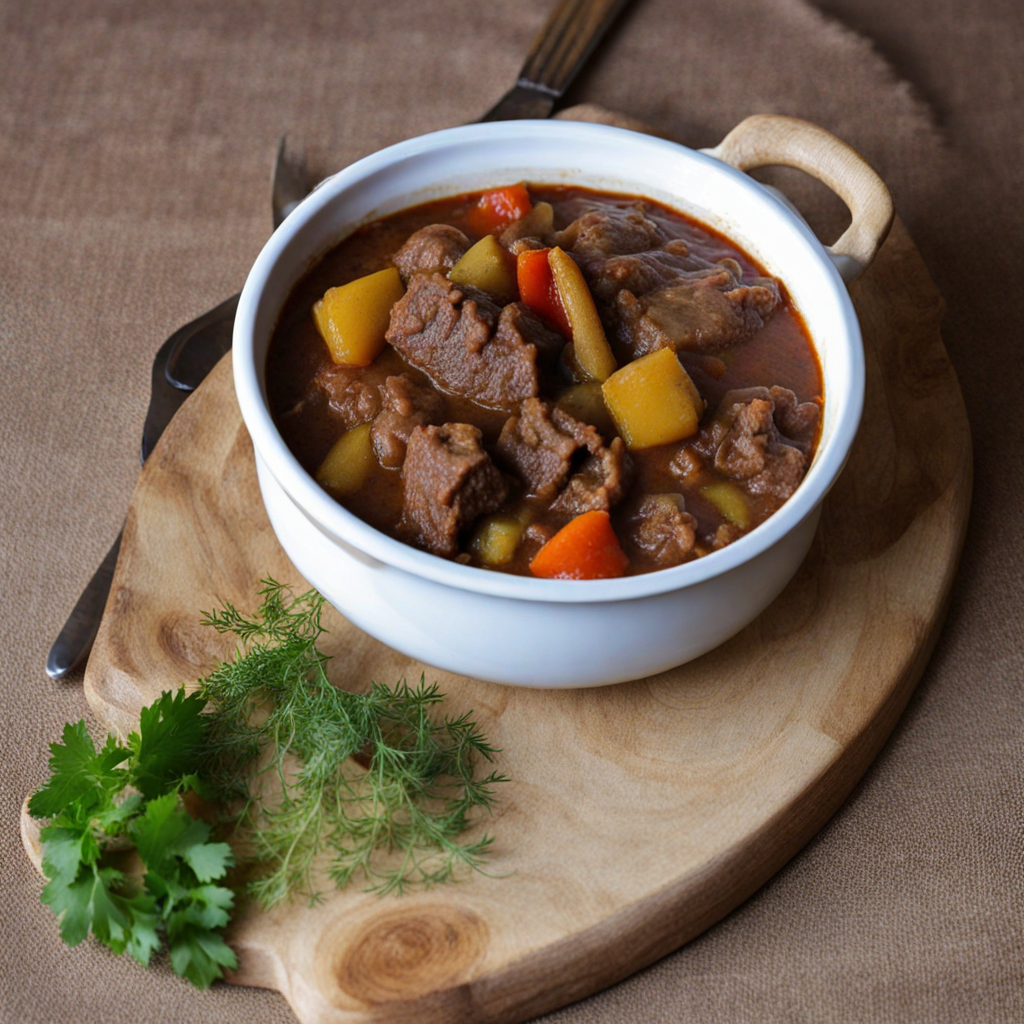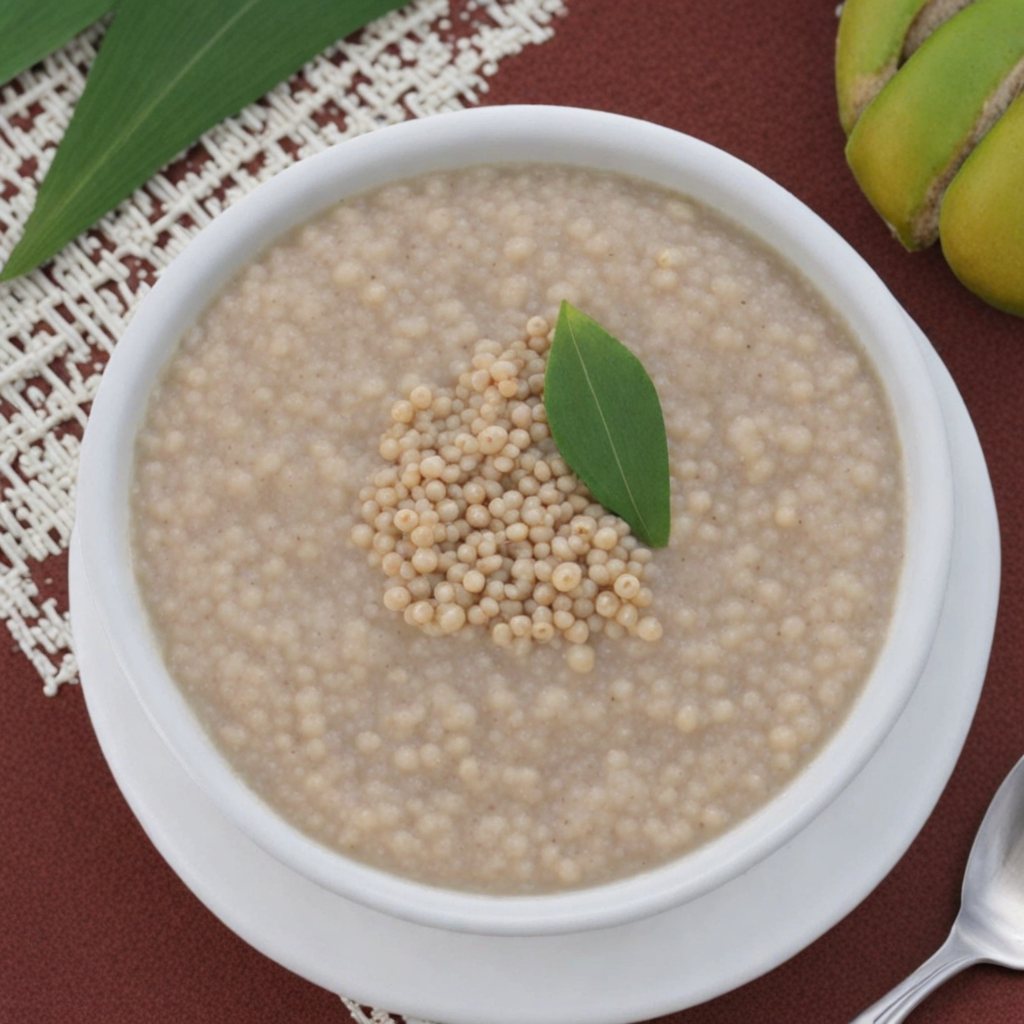Meat Stew
Meat stew, a cherished dish from Eswatini, offers a unique blend of flavors that reflect the country's rich culinary heritage. This hearty stew typically features tender chunks of beef or goat, simmered slowly to perfection. The meat is often marinated with local spices and herbs, which infuse it with a depth of flavor that is both savory and aromatic. As it cooks, the meat releases its juices, creating a rich, flavorful broth that serves as the base of the dish. The stew is enhanced by a variety of vegetables such as carrots, potatoes, and onions, which not only add texture but also contribute to the overall taste. Each ingredient is carefully selected to complement the meat, resulting in a harmonious blend of flavors. The vegetables soften in the simmering broth, absorbing the spices and creating a comforting dish that warms the soul. Traditionally, the stew is served with a side of mealie meal (a maize-based dish) or dumplings, which help to soak up the delicious sauce. Enjoying meat stew is not just about the taste; it's an experience that brings people together. Often served during family gatherings and celebrations, this dish embodies the spirit of community in Eswatini. As you savor each spoonful, you'll find the robust flavors and tender textures inviting you to explore more of the region's culinary diversity. The combination of ingredients and cooking techniques makes meat stew not just a meal, but a celebration of Swazi culture and tradition.
How It Became This Dish
The History of Umncuphu: A Culinary Gem from Eswatini Introduction Umncuphu, a traditional dish from Eswatini, encapsulates the essence of Swazi culture and culinary heritage. Made primarily from maize meal and often enriched with ingredients like pumpkin, beans, or leafy greens, this dish is not just a source of sustenance but also a reflection of the community's agricultural practices and social customs. This engaging narrative explores the origins, cultural significance, and evolution of Umncuphu within the context of Eswatini's rich history. Origins of Umncuphu Eswatini, a small landlocked kingdom in Southern Africa, is characterized by its diverse landscapes, ranging from lush mountains to arid plains. The Swazi people, who have inhabited this region for centuries, have cultivated maize, sorghum, and other crops, which are staples in their diet. The exact origins of Umncuphu may be difficult to pinpoint, but its roots can be traced back to the agricultural practices of the Swazi people, who have relied on maize as a primary food source. The name "Umncuphu" comes from the Swazi language, where "um" denotes "the" and "ncuphu" refers to the dish itself. Traditionally, it is prepared by boiling maize meal in water until it reaches a thick consistency, akin to porridge. Over time, the dish has evolved to include various ingredients based on seasonal availability and regional preferences, making it a versatile staple. Cultural Significance Umncuphu holds a significant place in Swazi culture, serving not only as a staple food but also as a symbol of unity and community. It is common for families to gather around a communal pot to share a meal, reinforcing social bonds and fostering a sense of togetherness. The act of eating Umncuphu is often associated with celebrations and gatherings, such as traditional ceremonies, weddings, and harvest festivals. In Swazi culture, food is interwoven with spirituality and identity. Umncuphu is often prepared for special occasions, serving as a way to honor ancestors and express gratitude for the harvest. The dish is sometimes accompanied by meat or vegetables, but its simplicity is what makes it special—highlighting the Swazi people’s connection to the land and their agricultural heritage. Development Over Time As Eswatini has undergone social and political transformations, so too has the preparation and consumption of Umncuphu. The colonial period in the late 19th and early 20th centuries introduced new agricultural practices, crops, and cooking methods to the region. While maize remained a staple, the incorporation of other ingredients into Umncuphu reflects the influence of various cultures and cuisines. Post-independence, in 1968, Eswatini experienced a resurgence in the appreciation of traditional foods. Efforts to promote local cuisine have been vital in fostering national pride and cultural identity. Umncuphu has found a place on the tables of both rural and urban families, bridging the gap between traditional and modern culinary practices. Modern variations of Umncuphu may include the addition of spices, herbs, and even dairy products, catering to contemporary palates while respecting the dish’s original essence. Furthermore, the rise of health consciousness among Swazi people has led to the exploration of alternative grains and legumes, making Umncuphu adaptable to dietary needs without losing its cultural significance. Umncuphu in Contemporary Eswatini Today, Umncuphu continues to be a beloved dish in Eswatini, enjoyed by people of all ages. Its preparation is often a communal activity, with family members participating in the cooking process, thereby passing down culinary skills and traditions from one generation to the next. The dish is frequently served with a variety of accompaniments, such as stews, sauces, or sautéed vegetables, showcasing its versatility. In the urban centers of Eswatini, Umncuphu has found its place in restaurants and food markets, where it is often featured alongside other traditional dishes. This visibility has helped to reinforce its status as a cultural icon and has made it accessible to both locals and tourists. Culinary tourism in Eswatini has begun to flourish, with visitors eager to experience authentic Swazi cuisine, among which Umncuphu holds a prominent position. Moreover, social media and food blogs have played a crucial role in popularizing Umncuphu beyond the borders of Eswatini. As more people become curious about African cuisines, Umncuphu stands out as a dish that tells a story of resilience, community, and tradition. Recipes are shared across platforms, allowing individuals to experiment with this traditional dish in their own kitchens, thus creating a global appreciation for its flavors. Conclusion Umncuphu is more than just a dish; it is a testament to the Swazi people's agricultural heritage, social values, and cultural identity. Its origins are deeply rooted in the land of Eswatini, and its significance as a communal meal fosters connections among families and communities. Throughout history, Umncuphu has adapted to changing circumstances, remaining a staple that reflects the resilience and creativity of the Swazi people. As Eswatini continues to navigate modernity while cherishing its traditions, Umncuphu will undoubtedly remain a beloved culinary gem. It serves as a reminder of the importance of food in preserving culture, fostering community, and celebrating identity—a dish that nourishes not only the body but also the spirit. Whether enjoyed in a rural homestead or a bustling urban restaurant, Umncuphu will continue to be a cherished part of Swazi life for generations to come.
You may like
Discover local flavors from Eswatini







